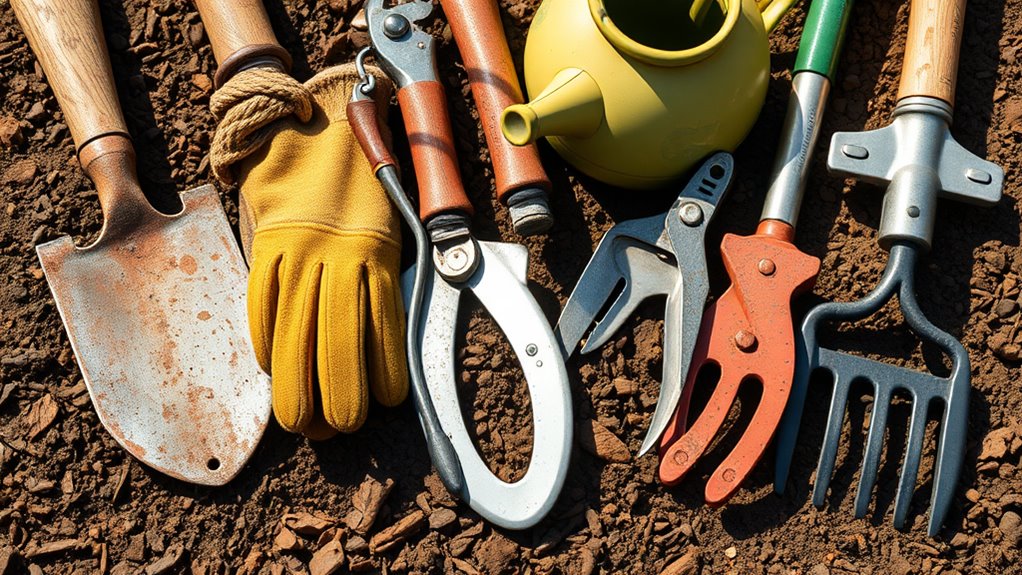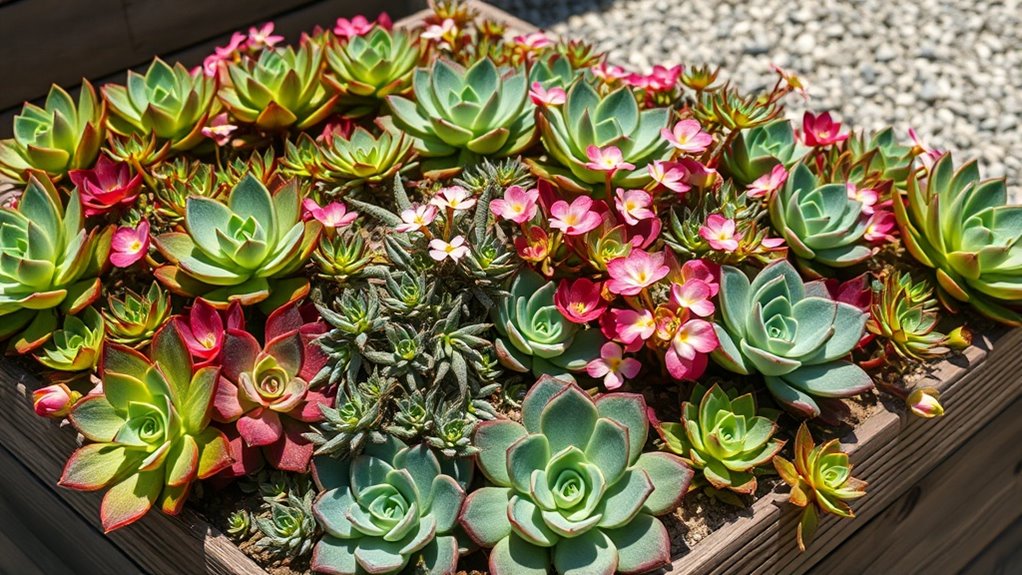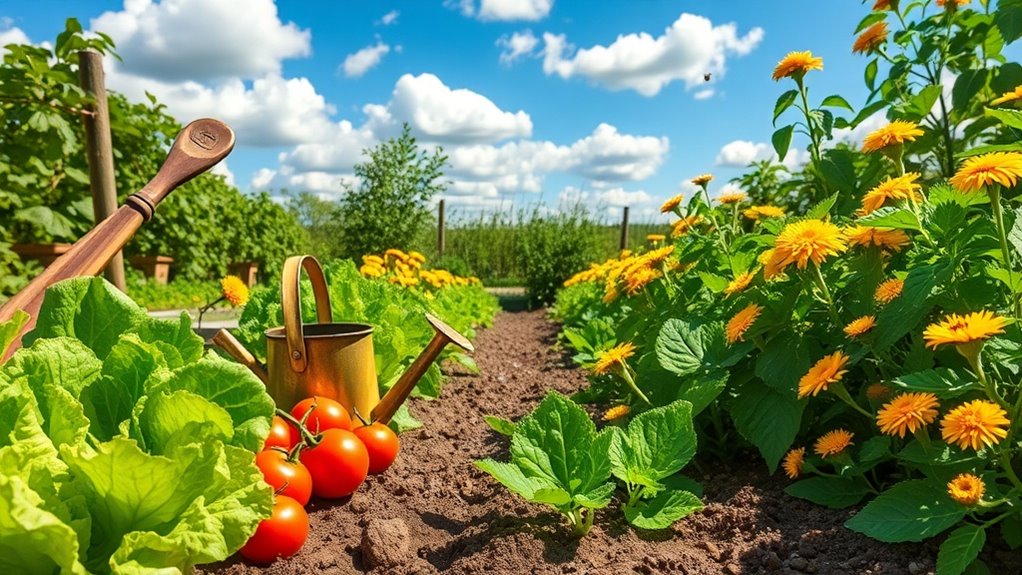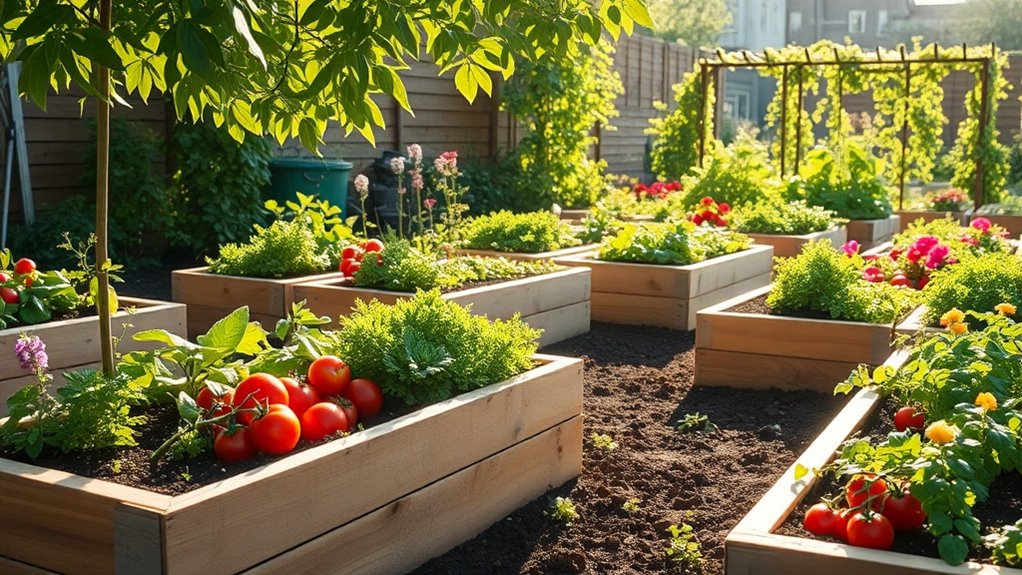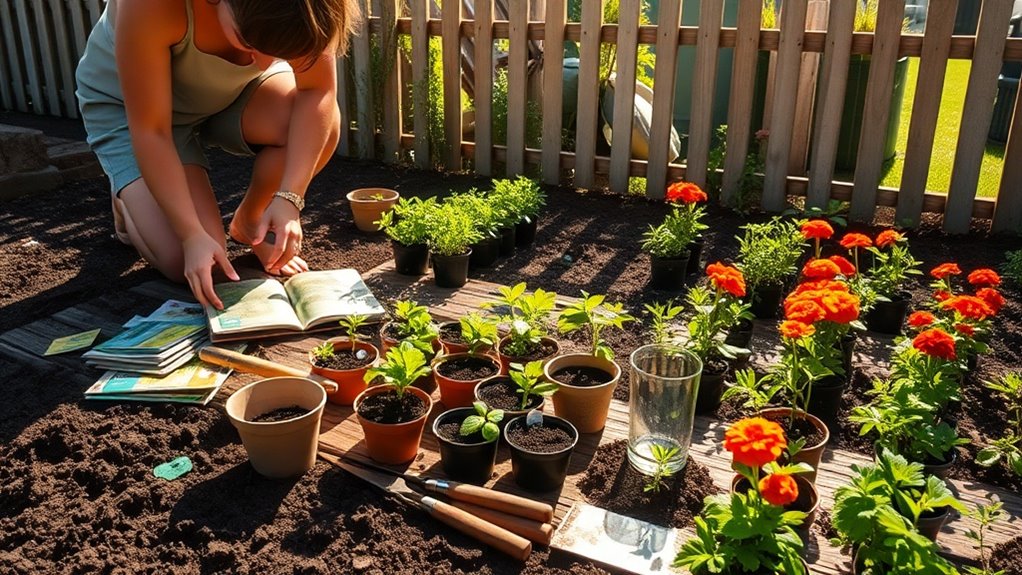7 Dirt-Cheap Gardening Tools That Actually Work
You’ll love these seven dirt-cheap gardening tools that actually deliver results. Grab a hand trowel for precise digging, pruning shears to trim plants easily, a watering can for even hydration, gardening gloves for protection, a garden hoe for efficient weeding, a compost bin for sustainable soil enrichment, and a seed tray for starting seedlings. Master their use with simple maintenance tips that boost your garden’s health and productivity.
Key Takeaways
- Hand trowels under $10 provide durable, precise digging for efficient planting.
- Pruning shears costing less than $15 effectively trim plants with ergonomic handles.
- Watering cans for under $10 deliver controlled hydration to prevent foliage diseases.
- Affordable gardening gloves protect hands from thorns and blisters for safe use.
- Compost bins around $10 recycle waste and produce natural soil enrichment.
The Hand Trowel
When you’re tackling your garden, the hand trowel stands out as an essential tool for precise digging and planting.
As a key player among gardening tools, it enables you to handle small-scale tasks like creating perfect holes for seeds or transplanting with minimal effort.
You’ll find its ergonomic handle reduces strain, while the sturdy blade cuts through soil efficiently.
Choose one made from durable materials to withstand frequent use.
Proper care, such as cleaning after each session, keeps it sharp and ready.
In your gardening tools arsenal, the hand trowel delivers reliability, making every project more productive and enjoyable. It is recognized as one of the three essential tools that enhance efficiency and productivity in gardening.
As one of the top five must-have tools, it helps ensure success in any garden setup.
Pruning Shears
Pruning shears rank as a vital tool in your gardening kit, expertly handling the trimming and shaping of plants to promote growth and health. By mastering the art of pruning, you can ensure your garden thrives as per effective methodologies.
You’ll find budget-friendly options under $15 at hardware stores or online, featuring bypass blades for clean cuts on live branches. Choose ergonomic handles to reduce strain during extended use.
Always sharpen them with a whetstone before sessions to ensure precision and prevent plant damage. Clean after each use with rubbing alcohol to avoid disease spread.
With proper care, these shears deliver reliable performance, helping you maintain a thriving garden affordably.
With these shears, you can effectively apply essential pruning techniques to significantly enhance the growth rate of your garden plants.
Watering Can
A watering can stands out as an essential tool for delivering precise hydration to your plants, ensuring they thrive without waste.
When selecting one, choose a durable plastic model under $10; it’s lightweight and features a fine rose for gentle watering. You control the flow easily, directing water to roots and avoiding foliage diseases. Additionally, expert watering techniques can enhance your plant care by addressing common pitfalls like overwatering.
For best results, fill it with room-temperature water to prevent shocking plants. Regularly clean the spout to maintain efficiency, extending its lifespan.
To make an informed choice, consider informed choice factors that align with your specific gardening needs.
Gardening Gloves
When you’re selecting gardening gloves, you’ll find that material options like leather, cotton, or nitrile each offer distinct advantages for different tasks.
These choices provide essential protection benefits, such as shielding your hands from thorns, blisters, and harsh chemicals.
Start by evaluating these factors to ensure your gloves enhance your gardening experience.
Moreover, incorporating essential maintenance tips can extend the life of your gardening gloves.
For budget-conscious gardeners, focusing on affordable options can help you access high-quality tools without overspending.
Material Options
Materials for gardening gloves greatly influence their durability, comfort, and protection.
You can choose leather for its toughness, ensuring gloves withstand frequent use and resist tears, though it may feel stiff initially.
Cotton options offer breathability and softness, ideal for extended wear in milder tasks, but they wear out quicker with rough handling.
Synthetic materials like nitrile deliver flexibility and longevity, maintaining shape through washes while providing a secure grip.
Select based on your needs—leather for durability, cotton for comfort—to maximize value in affordable gardening gear.
Protection Benefits
Gardening gloves deliver essential protection that keeps your hands safe from thorns, chemicals, and blisters during tough tasks.
You’ll avoid painful cuts and infections by selecting durable, puncture-resistant options that fit snugly. These gloves let you handle thorny plants or pesticides without hesitation, reducing downtime from injuries.
For budget-conscious gardeners, they prevent blisters on repetitive jobs like weeding or digging, boosting your efficiency.
Opt for ones with breathable fabric to minimize sweat buildup, ensuring comfort over long sessions.
Garden Hoe
When you’re selecting a garden hoe, you’ll find types like the stirrup or grub hoe that suit different soil conditions and tasks.
You can master weeding techniques by using the hoe’s blade to slice through weeds at the root, making your garden maintenance easier.
Keep your hoe in top shape with basic maintenance like sharpening the edge and oiling the metal to ensure it lasts for seasons.
Hoe Types
Various types of garden hoes can transform your weeding and soil prep, with each design tailored for specific tasks.
You’ll love the stirrup hoe for its ability to skim weeds just below the surface, minimizing soil disruption. A draw hoe helps you efficiently create furrows or mound soil around plants.
For precision in tight spots, grab a collinear hoe—it’s lightweight and easy to maneuver. These budget-friendly options, typically costing less than $15, deliver reliable performance, saving you time and effort in your garden maintenance.
Choose based on your soil type and plot size for optimal results.
Weeding Techniques
Effective weeding with a garden hoe starts by selecting the right type from those we’ve covered, like the stirrup or draw hoe, to match your garden’s needs.
You’ll slice weeds just below the soil surface using a smooth, pulling motion—keep the blade sharp for efficiency. Angle the hoe at 45 degrees and work in straight rows to avoid damaging plants.
For best results, weed on dry days when soil is firm, allowing you to uproot weeds without tilling too deeply.
Maintenance Basics
To keep your garden hoe performing at its best, you’ll need to maintain it regularly.
After each use, wipe off dirt and debris with a damp cloth, then dry it thoroughly to prevent rust.
Sharpen the blade using a metal file or stone, ensuring a keen edge for efficient digging and weeding.
Apply a light coat of oil to metal surfaces for corrosion protection.
Store your hoe in a dry, sheltered spot, away from moisture.
These straightforward steps extend its lifespan, save you money, and keep it ready for action, making your gardening efforts more effective.
Compost Bin
A compost bin stands as a reliable gardening essential, turning your kitchen scraps and yard waste into nutrient-rich soil with minimal effort.
It’s a dirt-cheap option you can build from recycled materials like old barrels or pallets for under $10, ensuring long-term savings.
Start layering greens (like vegetable peels) with browns (like leaves) for balanced decomposition, and keep the bin moist while turning it weekly to accelerate the process.
This practical tool reduces household waste, enriches your garden naturally, and delivers high-quality compost in months, making it a must-have for eco-friendly gardening. Following essential tips for recycling kitchen scraps and garden waste can further enhance soil health.
Embracing this approach not only recycles waste but also promotes garden sustainability as outlined in composting practices.
Seed Tray
Seed trays offer a straightforward way to kickstart your garden by germinating seeds indoors before transplanting.
You’ll save money by using affordable plastic or DIY versions from recycled materials, which cost under $5. Choose trays with drainage holes to prevent root rot, and fill them with a cheap seed-starting mix.
Plant your seeds at the right depth, water gently, and place them in a warm, sunny spot. Monitor moisture levels to avoid damping off, then harden off seedlings outdoors.
This method boosts germination rates, giving you stronger plants and a head start on the growing season, all without breaking the bank. To optimize seedling health, it’s advisable to conduct soil testing if you’re reusing potting mixes from previous seasons.
Remember that effective soil preparation is crucial even in seed trays, as the mix you use affects seedling health.

